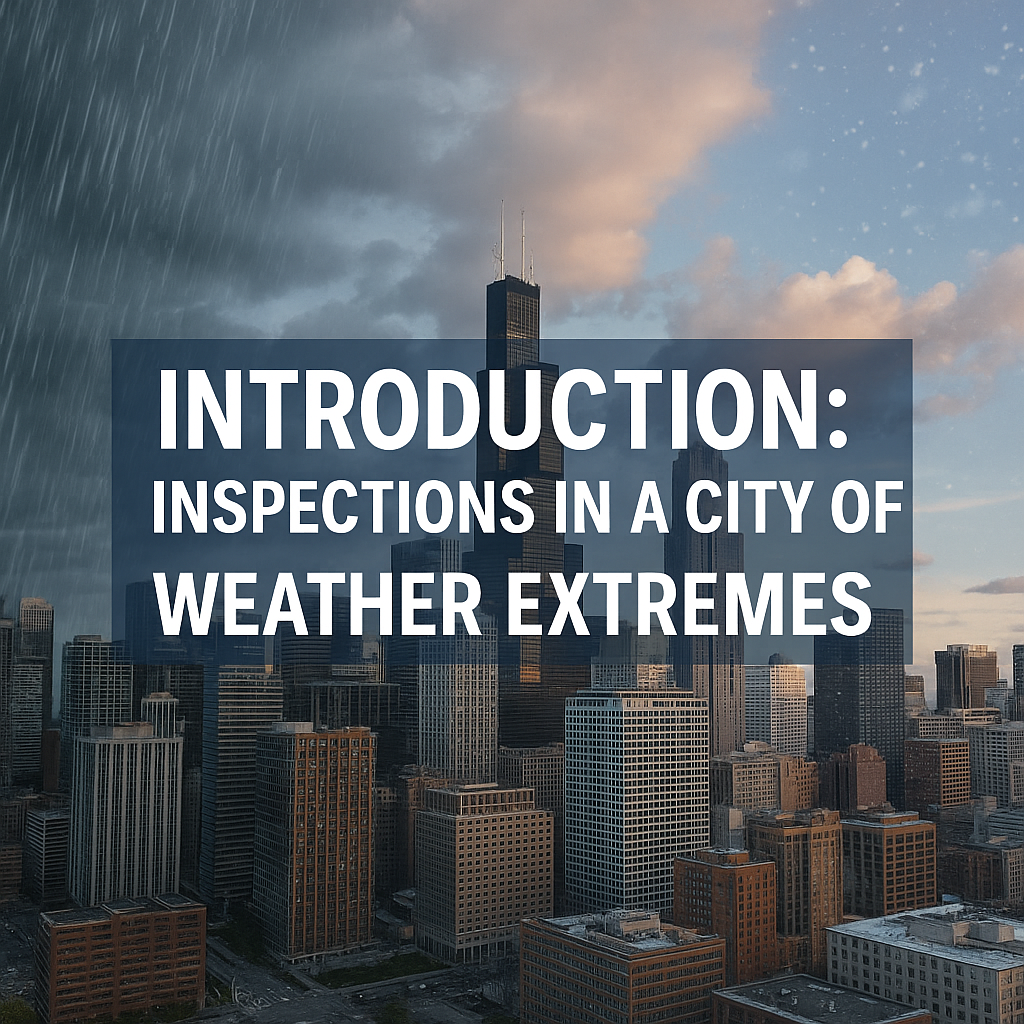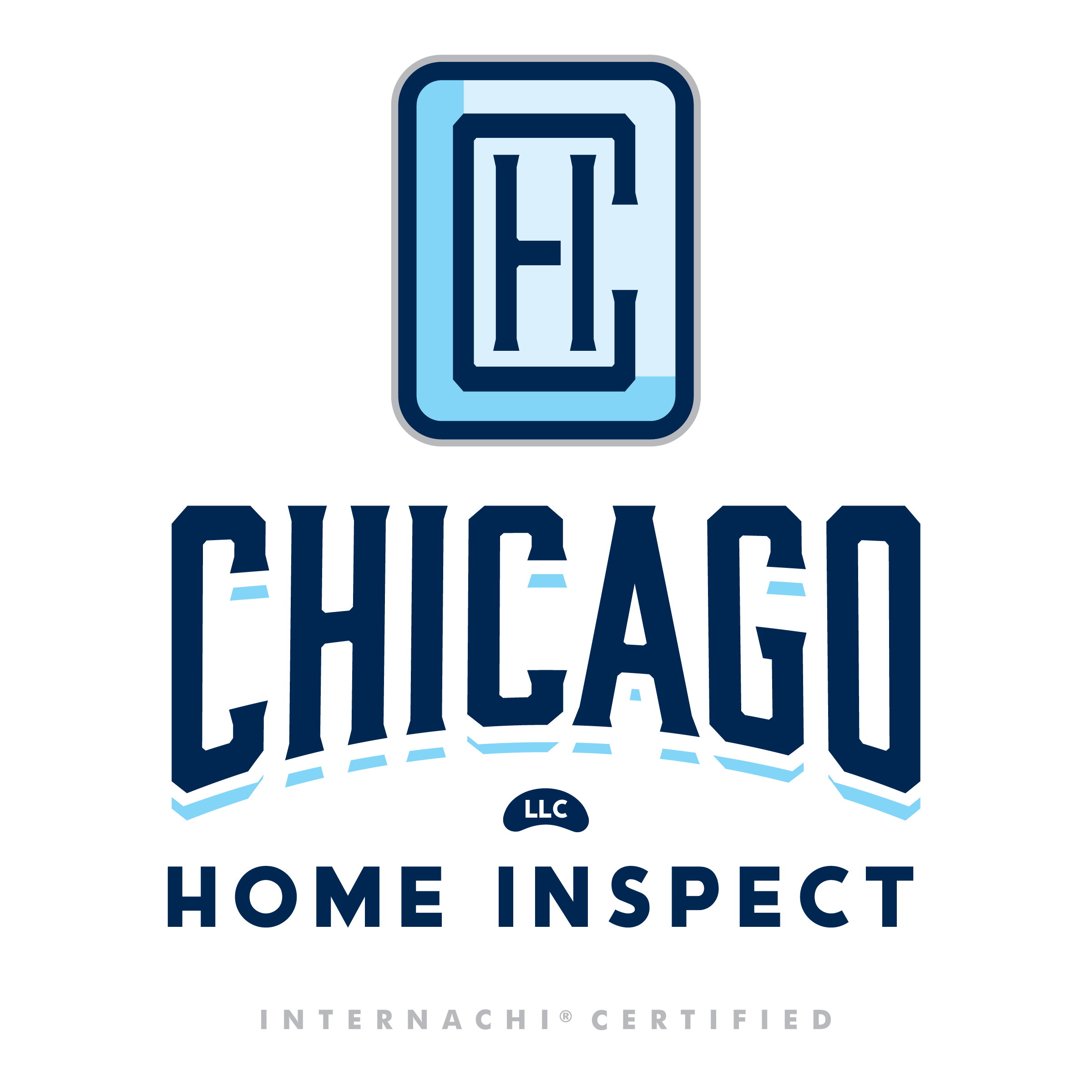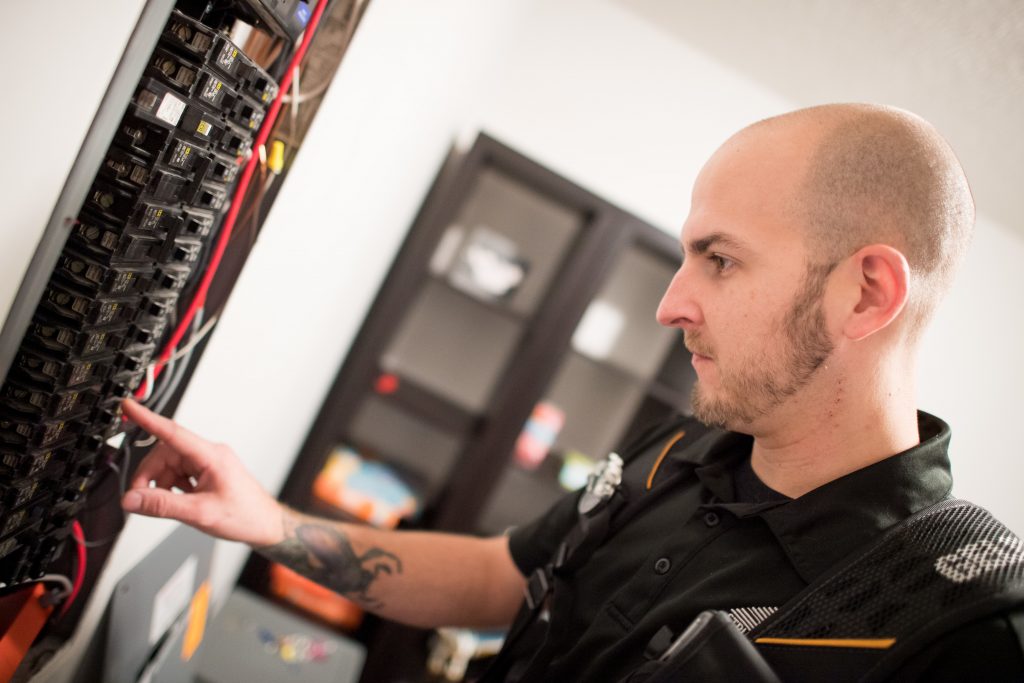
Chicagoans joke that you can experience all four seasons in a week, but for home inspectors in Chicago, that volatility is no laughing matter. The metro area just logged its warmest calendar year on record in 2024, saw 63 tornadoes in the forecast region, and finished the winter with barely 23 inches of snow—40 percent below normal. Those swings complicate everything an inspector tries to observe, from roof membranes to basement slabs.
This article unpacks, exactly how rain, heat, and snow can distort inspection findings, why timing matters, and what the best-equipped home inspectors in Chicago do to separate weather noise from genuine defects.
1. Why Weather Conditions Can Change the Inspection Story
A standard home inspection is a snapshot in time. Extreme weather turns that snapshot into a moving target:
| Weather Variable | What It Can Hide—or Heighten |
|---|---|
| Heavy rain | Makes active leaks obvious but can mask hairline roof cracks once surfaces dry. |
| Heat waves | Accelerate attic temperatures past 140 °F, exaggerating thermal-imaging contrasts and triggering false “hot-spot” alarms. |
| Fresh snow | Obscures roof shingles, flashing, decks, and grading. |
| Rapid freeze-thaw | Opens masonry joints overnight, creating new cracks after an inspector has left the site. |
Understanding these effects lets buyers and sellers interpret the report in context and decide whether a targeted re-inspection is worthwhile.
2. Rain: Friend and Foe of the Inspector
2.1 The Midwest’s New Rainfall Reality
Chicago’s heaviest downpours—precipitation events above the 99th percentile—have increased 45 percent since the 1950s. More frequent “cloudbursts” now dump two inches in an hour, quickly overwhelming vintage clay sewer lines and footing drains.
2.2 What Rain Reveals
- Active roof leaks and skylight failures. Water migrating through drywall shows up as fresh stains that infrared cameras outline clearly.
- Site drainage shortfalls. Ponding around the foundation, gutter overshoot, and back-pitched sidewalks are easiest to spot while water is flowing.
- Unsealed penetrations. Cables, plumbing vents, and electric masts that look fine when dry may drip visibly during a storm.
2.3 What Rain Conceals
- Small flashing gaps. Once the surface dries, tell-tale minerals and efflorescence may vanish.
- Hairline foundation cracks. Hydrostatic pressure swells existing fractures, then closes them within hours.
- Roof-surface evaluation. Many home inspectors in Chicago will not walk a steep asphalt-shingle roof that’s wet; they’ll switch to binoculars or drones, limiting tactile feedback.
2.4 Best-Practice Rain Protocols
- Moisture mapping each suspect wall with both a capacitance and a pin-type meter before and 24 hours after the storm.
- Sewer-scope or dye test if water backs up through floor drains.
- Client education: Rain during inspection day can be a bonus if you’re prepared to document and act quickly.
3. Heat: When the “Hawk” Takes a Summer Vacation
3.1 A Record-Hot Reality
The National Weather Service confirmed 2024 as Chicago’s warmest year since records began in 1872, punctuated by a June “heat dome” that locked daytime highs near 100 °F for a week. High humidity pushed heat-index values above 110 °F on multiple days.
3.2 Inspection Challenges in Extreme Heat
| System | Heat-Driven Complication |
|---|---|
| Roof | Asphalt shingles soften; granular loss accelerates, making age estimation tricky. |
| Electrical | Overheated transformers cause voltage drop; inspectors may record low readings that normalize in cooler weather. |
| Attic | Radiant temperatures skew thermal-imaging color scales, generating “phantom leaks.” |
| HVAC | Short cycling during high-load tests may suggest compressor failure when the unit is merely hitting its high-limit safety. |
3.3 Distinguishing True Defects from Heat Artifacts
- Baseline thermal scan at dusk. Waiting until outdoor temps fall below 85 °F narrows infrared deltas to manageable ranges.
- Checking manufacture dates. An eight-year-old shingle roof on a south-facing slope that is already shedding granules merits a closer core-sample even if softening is heat-related.
- Voltage-drop follow-up. Inspectors retest branch circuits under normal ambient conditions before citing deficiencies.
3.4 Why Buyers Should Care
Extreme heat events are forecast to triple in the Midwest by mid-century. Knowing a house can withstand those extremes—and documenting true, not heat-induced, deficiencies—protects both comfort and resale value.
4. Snow: When the Inspection Happens in a Whiteout—or a Winter Drought
4.1 Snowfall Trends You Can’t Predict
Snow totals around Chicago have grown wildly erratic: the region saw 67 inches in the brutal winter of 2014, but just 22.2 inches in 2023-24, one of the least snowy seasons on record.
4.2 When Snow Is on the Roof
- Visual blockage. Shingles, nail pops, chimney flashing, and roof-deck sagging disappear under a blanket of white.
- Safety limits. Many insurance carriers prohibit inspectors from climbing snow-covered roofs, and ladder footing on ice is unsafe.
- Ice dam bias. Actively melting eaves can exaggerate the perception of ventilation defects even when the attic meets code.
4.3 When There’s No Snow at All
A winter with sparse snow can fool you into thinking:
- Gutters are fine. Without melt cycles, loose spikes and mis-pitched runs stay put.
- Ground is stable. Frost heave evidence is harder to spot when soils never freeze deeply.
- Roof age looks better. UV damage is reduced without reflective snow cover; asphalt may look newer than it really is.
4.4 Best Practices for Home Inspectors in Chicago During Snow Season
- Drone imaging for high-resolution photos of concealed roof sections.
- Attic interior checks: Sheathing stains, rusted nails, and vapor marks betray leaks hidden by snow.
- Optional return visits: Many inspectors offer a reduced-fee roof-only inspection once the thaw arrives—an investment that can save buyers thousands.
5. Extreme Weather Scheduling Strategies
- Watch the 48-hour window. A heavy rain 24 hours before your appointment is ideal for drainage observations.
- Aim for shoulder seasons. April-May and September-October give balanced conditions for infrared and roof walking.
- Budget for re-inspections. If snow or torrential rain blocks critical systems, plan—and negotiate—for a follow-up contingency.
- Read the inspection agreement. Reputable home inspectors in Chicago spell out weather limitations and outline remedies such as photographs, drones, or deferred evaluations.
6. Tools & Techniques That Offset Weather Bias
| Tool | Weather Problem It Solves |
|---|---|
| Drones with 4K zoom | Let inspectors evaluate steep or snow-covered roofs from safe distances. |
| Moisture meters (capacitance & pin) | Distinguish new-rain leaks from historic stains. |
| High-resolution IR cameras with auto-calibration | Compensate for heat-dome temperature extremes. |
| Gas-sniffing combustible-gas detectors | Identify roof-ice heat tape faults without climbing. |
| Ground-penetrating radar (specialty add-on) | Detect slab voids created by freeze-thaw even when ground is snow-covered. |
Cutting-edge gear doesn’t replace experience, but it does give seasoned home inspectors in Chicago the data they need to make weather-aware calls.
7. What Buyers, Sellers, and Agents Should Do Next
- Ask about weather protocols when interviewing inspection companies. A pro will detail how rain, heat, or snow affect their scope and what extra services they offer.
- Read every limitation in the final report. If it states, “Roof could not be walked due to ice,” insist on drone photos or a post-thaw inspection credit.
- Document the weather during your inspection. Photos of standing water, attic temps, or snow depth help support future insurance or warranty claims.
- Update the maintenance list. If a downpour revealed a footer drain issue, fix it before resale even if the basement dries out later.
Conclusion: Turning Weather Challenges into Inspection Wins
Chicago’s rain bombs, heat domes, and snowfall whiplash are not going away; if anything, the science suggests they will intensify. The key is not to fear the forecast but to leverage it. A drenching spring storm can expose gutter leaks you’d never see in August; a 98-degree attic can spotlight insulation voids; a February whiteout, if you know where to aim the infrared, can outline heat-loss paths with laser precision.
Sophisticated home inspectors in Chicago use that knowledge—along with drones, calibrated IR cameras, moisture meters, and crystal-clear client communication—to produce reports that separate transient weather artifacts from true, latent defects. Buyers gain negotiating power, sellers avoid surprise concessions, and agents move deals forward backed by fact, not guesswork.
Whether you’re booking an inspection tomorrow or six months out, remember: Environmental conditions will skew results. Choose an inspector who embraces those variables, documents them, and offers intelligent follow-ups. That weather-savvy approach is the surest way to keep Chicago’s legendary climate from blindsiding your next real-estate decision.



